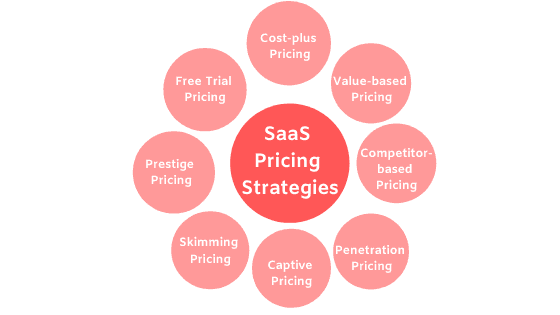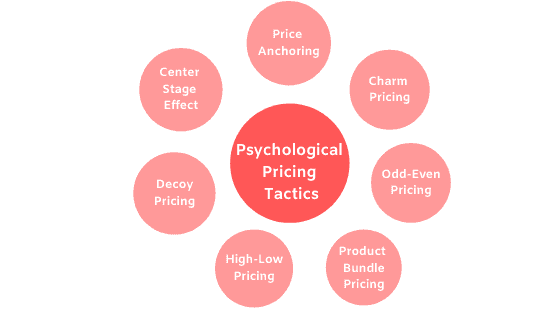The goal of any business is to make customers use their products and services. In order to do that, companies should implement the best pricing models that attract customers, as well as, that fits the companies.
The pricing strategy is what makes your company successful. It is like a double-edged sword. It can either make your company successful or break your company. So, you need to understand the SaaS pricing strategies and implement the best one.
What is a Pricing Strategy?
A pricing strategy is a method to implement the best pricing models that maximize a company’s profits. It includes establishing the best price for the company’s products and services.
Every company maximizes its sales and profits by implementing the best pricing strategies and choosing the best pricing models. They maximize their sales and profits by selling their products and services at an appropriate price.
Steps Before Choosing the Right Pricing Strategies
You need to consider many factors such as market demand, your business strengths and weaknesses, competitors, etc. before implementing pricing strategies. You are likely to fail if you do not implement the best strategy considering these factors.
Pricing is the heart of any business. So, you need to price your products and services in such a way that people will accept. And it’s not easy to select the best pricing strategies and price your products and services. So, what do you need to do before choosing the right pricing strategies?
- Identify the Target Audience

First, you need to identify potential customers that are going to use your products and services. You need to identify their needs and problems. Without analyzing the customers, you cannot choose the appropriate price for your products and services.
Your company exists for customers and your company will be in the market because of the customers. So, you need to provide products and services that will fulfill their needs and solve their problems. You need to meet their demands and expectations.
Not only their needs or problems, but you should also need to identify their ability and willingness to pay. So, you need to focus on the value and benefits that you provide to your customers.
- Identify Your Product’s Competitive Strength

To flourish your business, you need to identify your product’s strengths and weaknesses. You need to know whether your products and services can compete in the market or not.
You need to list out your products and services unique features that cannot be duplicated. You need to make such products and services that will differentiate you from others and give you a competitive advantage. You need to provide the best features at a valuable price.
- Performing Competitive Pricing Analysis

You need to identify your competitors in the market. You are in a competitive world where customer satisfaction matters. You need to put customers above everything and work to satisfy them.
You should study in detail about your competitors and their strategies. You need to identify their strengths and weaknesses. You should identify their weaknesses and look for the opportunity to strike. You just need to find an opening.
You need to identify their pricing strategies and you should provide quality products and services at an affordable price than your competitors.
- Conducting Market Research

You need to research thoroughly on whether the market segment you are targeting is growing or going to collapse soon. You need to target such a market segment with a high success rate. You need to select such a market section that is profitable and feasible for you.
You need to understand market trends and demand. This will give you an idea about the features that will make your products and services unique and more demanding.
- Select the Pricing Strategy and Execute

It is not necessary to get the right pricing strategies on the first try. So, keep experimenting until you find the best one for your company. You just need to keep experimenting and identify a strategy that works for you.
When selecting the pricing strategy, you need to align such pricing strategies with the company’s visions and goals. And devise various plans and execute such plans to get the best for your company.
Pricing Strategies
Now you know what you need to do before choosing the right pricing strategies for your company. So, here is the list of different pricing strategies you need to consider.

-
Cost-plus Pricing
In a cost-plus pricing strategy, the company calculates the total development cost of the product and adds the profit margin to determine the cost of products and services. And for a SaaS company, the development cost includes product development and design cost, testing cost, developer’s salary, etc.
The cost-plus pricing strategy doesn’t consider market value, competitor’s price, costumer’s ability and willingness to pay, etc.
-
Value-based Pricing
Value-based pricing focuses on the value provided by a product or service to the customers. The cost of a product or service is determined based on the customer’s willingness to pay. Instead of determining a price based on competitors, value-based pricing focuses on the value that you provide to your customers.
Value-based pricing provides products and services that the customers are looking for. You provide products and services with features they need at a valuable price. But, it takes a lot of your time to know what your customers need and to determine a valuable price to charge.
-
Competitor-based Pricing
Competitor-based pricing strategy is one of the most used pricing strategies. In this competitive market, every business wants to be ahead of their competitors. Thus, a competitor-based strategy emerged.
In a competitor-based pricing strategy, the price of products and services is determined based on the competitor’s charging price. You basically provide quality products and services at an affordable price than your competitors. You need to research your competitor’s pricing strategies in order to provide better products and services at an affordable price that will attract your customers.
If you can provide quality products and services at an affordable price than your competitors, then this could be ideal for you. Otherwise, you might be falling into quicksand.
-
Penetration Pricing
Every business wants to enter the market and be successful. They want their products and services to be successful and well-known. In order to do this, the company prices its products and services lower than what their competitors are offering.
In penetration pricing, the company lowers its products and services just to enter into the market. By providing the products and services at a lower price, they attract customers and occupy most of the market segment.
The companies initially bear losses by offering products and services at a lower price. But, once their products and services are well-known and set a strong foothold in the market, the companies raise the prices to maximize profits without losing much of their customers.
-
Captive Pricing
Captive pricing is a strategy to make customers captive to use their products and services. In this pricing strategy, the companies offer products and services at a lower price or for free initially. The companies then charge extra or release the latest or premium versions to take advantage of the products and services.
Such companies leave no choice for customers. Either the customers have to upgrade the products or services or have to look for other products and services providing them better value. The customers are like prisoners where they have no choice but to use the products and services.
-
Skimming Pricing
Skimming pricing is a strategy where a company charges a high price for its products and services when launched in the market when it has fewer competitors. It is done in order to maximize profit at an early stage.
The price of the products and services is gradually lowered to attract price-sensitive customers. Thus, attracting customers with the ability and willingness to pay high as well as to pay low. The skimming price is a strategy to maximize the profit at an early stage and recover the development cost of the products and services.
-
Prestige Pricing
Prestige pricing is also known as premium pricing or image pricing. In this pricing strategy, the company charges a high price for its products and services to give it a premium and luxury feel. The company charges a high price knowing that it has a good reputation and is well-known in the market.
The company charges a high price because it has a unique product and services and has a high competitive advantage in the market. The customers perceive the products and services giving higher value than other products and services in the market. Higher the price, the more the value of the product.
-
Free Trial Pricing
In the free trial pricing strategy, the products and services are provided for free or for a limited time. This is done to grab the customer’s attention quickly and attract more and more customers. The customers use the products and services for free without paying any money.
After a certain time or level of usage or when the trial period ends, the customers are convinced to upgrade to premium versions to get additional features and get better value. The customers are provided with free products and services to make them addicted to the products and services and convince them to use the products and services on a long-term basis.
Psychological Pricing Tactics
Psychological pricing is a strategy that affects the customer’s purchasing decision. The companies price their products and services in such a way that it affects a customer’s brain encouraging them to purchase a product and service.
Let’s see some of the psychological pricing tactics that are practiced by different businesses.

-
Price Anchoring
Price anchoring is a technique in which the price of a product or a service affects the other prices. For example, you see a $100 watch but when you see a $90 watch next to it, it seems cheap and you are ready to buy a $90 watch. This is known as price anchoring where one price is affected by another price.
The purchase decision of a customer is affected by the first price he/she sees. So, most of the companies determine the price by displaying the high or low price first or comparing it with the competitors having a psychological impact on customers.
-
Charm Pricing
Charm pricing is a strategy in which the price points are ended with digit 9. Most of the companies use this strategy to increase their sales. The purchase decision is affected by the digit 9.
This pricing strategy works because our decision is affected by the left-most digits in the price. It is also known as the “Left Digit Effect”. For example, if we see $400 and $399, our brain processes the left-most digit and makes decisions accordingly choosing the price of $399. Because we perceive $399 closer to $300, not to $400.
-
Odd-Even Pricing
The odd-even pricing is similar to charm pricing. In this pricing strategy, the prices are reduced just by a fraction, making it more appealing to the customers. For example, the pricing ending at $4.95 or $4.99 is more appealing to the users than $5.00. In this case, the customers perceive such prices to be closer to $4.00, not to $5.00.
In this pricing strategy, the company avoids prices such as $100, $200, etc. Instead, they use prices such as $99.95, $199.99, and so on.
-
Product Bundle Pricing
In product bundle pricing, different products or services are combined into a single package and offered at a single price. The price of the package is less compared to the individual price of the products and services.
This pricing strategy is ideal when the number of products and services is more. For example, the Microsoft Office Suite.
-
High-low Pricing
High-low pricing is one of the most commonly used pricing strategies. Initially, the products and services are released at a high price and later the products and services are offered at a low price as a discounted value or in a sale.
When the demand for the products or services decreases, normally such products and services are sold at a discount or through clearance sales. It is a commonly used tactic to attract customers. For example, the price of a watch — $400 is crossed and new price next to it, $349.
-
Decoy Pricing
In the decoy pricing strategy, the customer is forced to make a choice. This strategy is used by the companies to boost their sales which include high priced products and services. This is a commonly used tactic to influence the customer’s purchase decision.
For example, if a package is priced at $50 and $100, then most of the customers will go for a $50 plan. But if a $90 plan is added in the package, then people will go for a $100 plan because it’s only $10 more than $90 plan. Here, the $90 plan is a decoy to make customers buy the $100 plan.
-
Center Stage Effect
The center stage effect is similar to the decoy pricing strategy. In this price strategy, generally, the products and services are divided into three plans at a particular price including different features. Example, basic, standard, and advanced.
The customers are available with three choices. And, most of the customers choose the middle one because the customers perceive the middle one as a safe bet. Most of the time, the most popular ones are always centered. Because of this, most of the customers choose the middle one to take fewer risks.
The above mentioned are the pricing strategies that are used by different businesses. The main goal of every business is to make customers buy their products and services. Pricing is one of the important aspects that affect the customer’s purchase decision. So, you must choose the pricing strategy that is perfect for your business.
